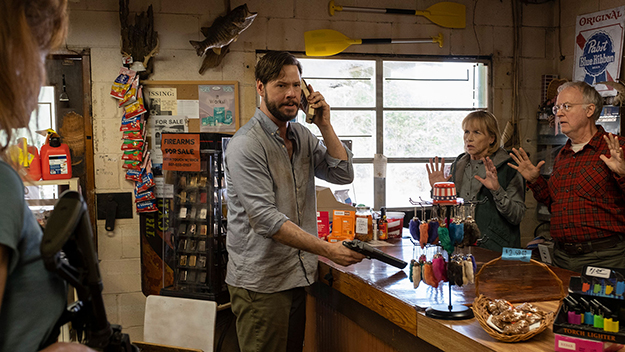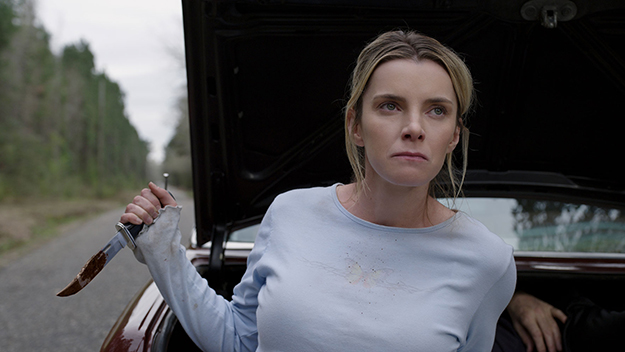But you can’t keep a canny exploitation movie down, and this one has a hook that’s a doozy: a handful of left-wing one-percenters kidnap a dozen “deplorables” and use them as targets in cathartic blood sport. The creative team—director Craig Zobel and cowriter-producers Nick Cuse and Damon Lindelof (all worked together on HBO’s The Leftovers)—stretch that hook into a hanger for outrageous blood-soaked slapstick and broad political jests. The film has almost no setup and precious little follow-through. Audiences never see the well-heeled Hunters gather and drug their victims and don’t learn how limousine liberals selected gun nuts and conspiracy theorists until the halfway mark. (The explanation muddies the waters: it also turns their hate crimes into acts of revenge.) After a shocking “gotcha” prologue, we’re simply dumped with human targets on a killing field, as the hidden left-wing cadre picks them off with bullets, arrows, and grenades. Aside from two extended trick scenes and a couple of narrative turnarounds, the plot quickly winnows the male prey down. Left longest are the obstreperous Gary (Ethan Suplee)—also known as “Shut-the-Fuck-Up” Gary—and the avuncular Don (Wayne Duvall), an endomorph in an Airborne cap. The last woman standing is a remarkably fit and resourceful Mississippian named Crystal (Betty Gilpin), who may not be deplorable at all. Zobel, Cuse and Lindelof organize the mayhem and broadsides as if spinning a wheel of misfortune. Their scattershot barbs land equally on the progressive elite of Democratic donors and the retrogressive hoi polloi of the Republican base. The jokes often operate like comic boomerangs, doubling back on the men and women who deliver the punchlines. One of the Hunters addresses his coed group as “guys,” then apologizes, “Sorry, I gendered it.” When “Shut-the-fuck-up” Gary confronts Arab refugees on the run, this Alex Jones-like podcaster, with the split-second malice of an ultra-right-wing cynic, labels them “crisis actors.” When Crystal points out that one of them has an infant, Gary dubs it a “crisis baby.”
The filmmakers don’t always riff on extremism and polarization as cleverly as they think. Why don’t the Hunters try to snatch any billionaire camp followers of the president they call the “ratfucker-in-chief?” The hangers-on at Mar-a-Lago might be more difficult to snatch than the denizens of dive bars, but the Hunters surely could have found some hate-spewing offspring of a right-wing media tycoon, or oil baron, or black ops magnate. A movie featuring only nefarious liberal billionaires dooms itself to silliness in the long run. And with left-wingers in charge of the homicide game, how are the homages to Animal Farm supposed to work? I liked the Dada touch of the Hunters releasing a pig among the Hunted named “Orwell.” What escapes me are how the head Hunter’s estate, “the Manor,” relates to Orwell’s “Manor Farm” (the site that becomes “Animal Farm” in Orwell’s book), and why the elitists name one of the Hunted “Snowball,” after Orwell’s Trotskyist pig. The ultra-P.C. Hunters would not see themselves as human oppressors or their ideological enemies as revolutionaries. They’re revolting, yes, but not revolutionary. (The delicious payoff to the Animal Farm gags almost compensates for the protracted buildup.) The movie’s unabashed effrontery connects it to American cinema’s great B-picture and exploitation past, including films like Barry Shear’s Wild in the Streets (1968), the major counterculture hit about a rock star who rises to the presidency and sends everyone over age 35 to “re-education camps.” But Wild in the Streets thrived in a drive-in/grindhouse/midnight-movie culture we no longer have. If Zobel, Cuse, and Lindelof had needed to shove their film out swiftly in that marketplace, they might have snuck in even more up-to-the-minute topics and left more room for the ensemble to improvise and fill out their sociopolitical cartoons. Today’s heavy-handed publicity campaigns are a drawback, too. A movie as arch as The Hunt requires whiplash plot turns to keep jolting us, but the trailer gives most of them away. Even if we enter the film over-prepared, we can appreciate how efficiently the filmmakers shred, spike, blast, and obliterate the cast, drawing on sources as different as Psycho and the original humans-hunting-humans adventure, the oft-remade The Most Dangerous Game. Still, what a decadent way to respond to a bloody burlesque like The Hunt. We want additional master strokes, like the first big set piece unfolding like a Hunger Games for unwitting adults. We yearn for more unexpected filigree, like the wooden balls of an odd chandelier turning into weaponry. Happily, when inspiration runs dry or genre restrains him, Zobel (Compliance, Z for Zachariah) has enough zest as an actor’s director to keep the pot boiling. Emma Roberts has rarely been more vivid or appealing than as one of the Hunted aptly and solely referred to in the credits as “Yoga Pants.” In one of the few layered sequences, Amy Madigan and Reid Birney, as the “Ma” and “Pop” owners of a gas station and country store called Ma and Pop’s Main Street Market, play off each other like first-rate sketch artists who’ve been harmonizing comically for decades. Hilary Swank brings all her dogged physicality and steely focus to Athena, the Hunt’s prime mover. Wallis Simpson, Duchess of Windsor, is supposed to have said, “You can never be too thin or too rich.” Swank’s Athena might add, “or too toned.” Swanks uses her trademark urgency to create a character packed with muscle, savvy and wounded pride. You wouldn’t want to meet her in a dark alley or a brightly lit kitchen.
Best of all, Betty Gilpin gives a kick-ass performance as a Mississippi gal named Crystal, who is fed up with hard knocks after spending too much time behind the counter at a rental-car agency following military service in Afghanistan. She is merely presumed to be deplorable. She is literate, terse, and sardonic. She knows that as far as this country goes, she’s a wasted human resource. With deadpan perceptiveness that draws us in, and uncanny eye-hand coordination, Gilpin’s Crystal reacts to conflict in the moment, and only in the moment. She keeps her back story way back. We’re with her 100% as she analyzes each risk and conquers it with ingenious, cool ferocity. Crystal simmers with pent-up anger but is so unable to articulate her fury that she resorts to an ominous hum that seems to electrify her face. Gilpin turns this bit of audiovisual business into brilliant shtick. In her objectivity and nonverbal communication, she’s a bit like Kurosawa and Mifune’s Yojimbo, except he killed people on both sides. Cuse and Lindelof hand Gilpin the best speech in the movie: Crystal’s mother’s version of Aesop’s Fable “The Tortoise and the Hare,” reframed with a climactic, horrific home invasion that alters the meaning of the story. Crystal’s dry-ice smokin’ recitation lets us see it as her mom did: not as a moral tale that elevates unswerving steadiness over careless nimbleness, but as a social parable that illustrates the arrogant wielding power over the humble. That’s how the filmmakers treat the fable, too, when they invoke the tortoise at the beginning of the film and the hare at the end. Gilpin’s performance provides a different context and content for the fable. Her solidity anchors the film and her agility keeps it all revved up. She is both the Tortoise and the Hare. Michael Sragow is a contributing editor to Film Comment and writes its Deep Focus column. He is a member of the National Society of Film Critics and the Los Angeles Film Critics Association.


